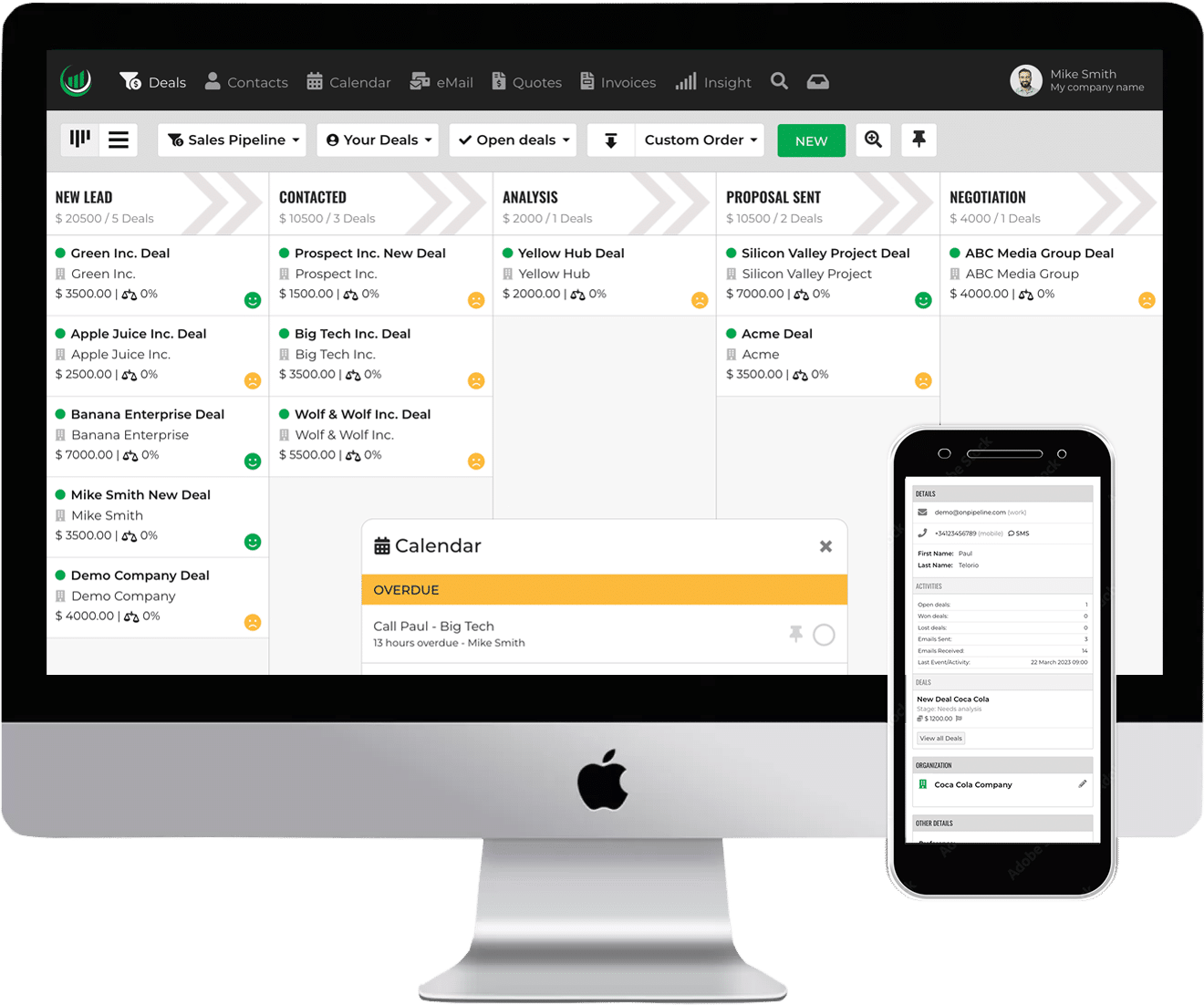The Pipeline Stages bring deals to the next phase, and make customers ready to buy. It should match your process, neither too long nor too short. This article explains how to create a pipeline and how many stages to use for better deal management.
What is a Sales Pipeline
At its most basic, a sales pipeline is a model that identifies the stages a customer will go through before they purchase your product. There are many pipeline models out there. Classic sales pipeline template options include the AIDA model and the Marketing RaDaR model.
The Sales Pipeline Model
The AIDA model outlines four key sales pipeline stages: Attention, Interest, Desire, and Action.
However, you can tailor these stages to better fit your specific sales process. A customized pipeline that considers your company’s unique circumstances may be the most effective approach.
For example, a sales pipeline like the one below meets the needs of most businesses.
- Prospecting (the mechanism to obtain new sales prospects of leads)
- Lead qualification (checking that the leads you’re getting are from individuals or companies that are most likely to want what you’ve got to offer).
- Developing a suitable invitation or proposal.
- Raising interest (perhaps by inviting prospective customers to enjoy a FREE trial or provide a suitable demonstration).
- Overcoming sales objections to purchase
- Negotiating in order to obtain a favorable outcome.
Real Objectives of a Sales Pipeline
The Pipeline provides clarity of purpose and links action to outcomes. As such, it offers direction and provides a useful tool for accountability. If you try to sell without a clear sales process, it’s hard to know why a sale succeeds or fails.
A Tool for Learning
If you can identify where your mistakes are, it’s possible to learn from them with a view to improvement. When created right, the sales pipeline lets everyone on the team see what needs to change.
A Tool for Improvement
Once you have determined the process for sales, you can examine it in depth to identify any omissions and weak points in your current operation.
If you’re not getting the results you need, there’s a need to do things differently! Therefore, you can use a sales pipeline to determine where the weak points are and take focused, effective actions.
Creates Cohesion and Teamwork
To sell effectively, you should focus less on how each worker performs. Salespeople used to only think about their selling skills and not the entire sales process.
Therefore, this may result in team members being unfairly blamed for poor sales when the reality is that the weakness lies in other areas of the process (such as poor-quality leads or weak after-sales care that generates negative customer reviews).
In short, a sales plan helps everyone on the team follow the right schedule. Clear guidelines empower and motivate employees, which is crucial in the workplace.
Facilitates Accurate Forecasting
Accurate forecasting of future profit is critical to successful financial management.
To plan well for the future, we need to know how often the sales team will close deals in the coming week, month, or year. This helps with organizational change.
Part of the pipeline process involves the production of a regular pipeline report in your Sales CRM.
Pipeline software provides real-time information on every aspect of your sales activity. Displayed in an accessible format, pipeline intelligence provides the data your business needs for high-caliber planning and sales management.
Increases Profits
Studies show that companies with a carefully designed sales process tend to make more money.
How to Build a Sales Pipeline
There are several different methods of building an effective sales pipeline. Since most companies have a sales pipeline, they may only need to make small changes to improve it.
In other cases, we will need to create the pipeline from scratch.
In the first instance, it’s helpful to have information on your customer base. The more information you have, the easier it is to determine what type of sales funnel is going to work best for your organization.
Establish Your Sales Stages
To begin, find a model with clear stages that makes sense for your business.
Decide on Your Outcomes
After you figure out the stages in your sales cycle, think about the goals you want to achieve.
Also to sales goals, consider other outcomes like customer engagement and raising awareness. Focus on increasing the value of each sale, not just the number of sales.
Get the Right Data
High-grade data informs the best pipelines! To improve your results, learn about your audience and how they respond to your marketing.
Get Input From the Sales Team
The sales team handles delivering important stages of the pipeline.
In order to improve your pipeline, it’s important to know what works well and areas that need improvement.
Involving the sales team from the start will boost their motivation to run the pipeline well. These are important for achieving your desired outcome.
Monitor, Evaluate and Review Your Pipeline
As we gain further insight into what works well and where improvements are needed, we will continuously evolve the sales pipeline.
Accessible, accurate, and relevant data drives effective monitoring and evaluation. Ensuring the pipeline is supported by effective data gathering is critical to success.
The success or otherwise of a sale can alter quickly. Real-time data on how far down the pipeline has progressed can help sales teams quickly adapt their approach to optimize the chances of achieving the desired outcome.
The Optimal Number of Stages
Business-Specific Considerations
The short answer to this question is that it depends on the nature of your business. Too many, and you’ll end up so immersed in the minutiae of the process that the end goal ceases to be the main focus. Too few, and you may lack the detail needed to evaluate what’s working well and what needs improving.
Standard Ranges for Sales Pipelines
For most companies, a sales pipeline (or sales funnel) will have somewhere between five and seven discreet stages. Within these stages, there may be multiple elements that need to be considered, which is where a checklist format can come in handy.
Continuous Monitoring and Adaptation
Like any other operational tool, it’s important that the sales pipeline remains a living document that’s regularly monitored, reviewed, and evaluated.
Data-Driven Adjustments
Obtaining quantitative (from analytics, conversion rates, performance reports, and financial monitoring) alongside qualitative (feedback from customers, the sales team, or your sales rep, for example) helps to determine whether you need to add or remove a pipeline stage.
Customizing for Product/Service
Depending on your setup, it may be more beneficial to set up multiple pipelines, with each being customized to suit the needs of a specific product or service.
Seeking Expertise
Building a sales pipeline can be a challenge, which is why many companies seek outside expertise to ensure their pipeline is as good as it can be.
Onpipeline offers a complete CRM software for businesses seeking to implement a high-grade sales pipeline that delivers the outcomes they’re looking for.
The package is easy to use and contains features that facilitate an easily accessible, responsive pipeline, Onpipeline’s package is available for FREE trial.
Get in touch to find out more about the benefits Onpipeline can bring to your sales and marketing processes.


